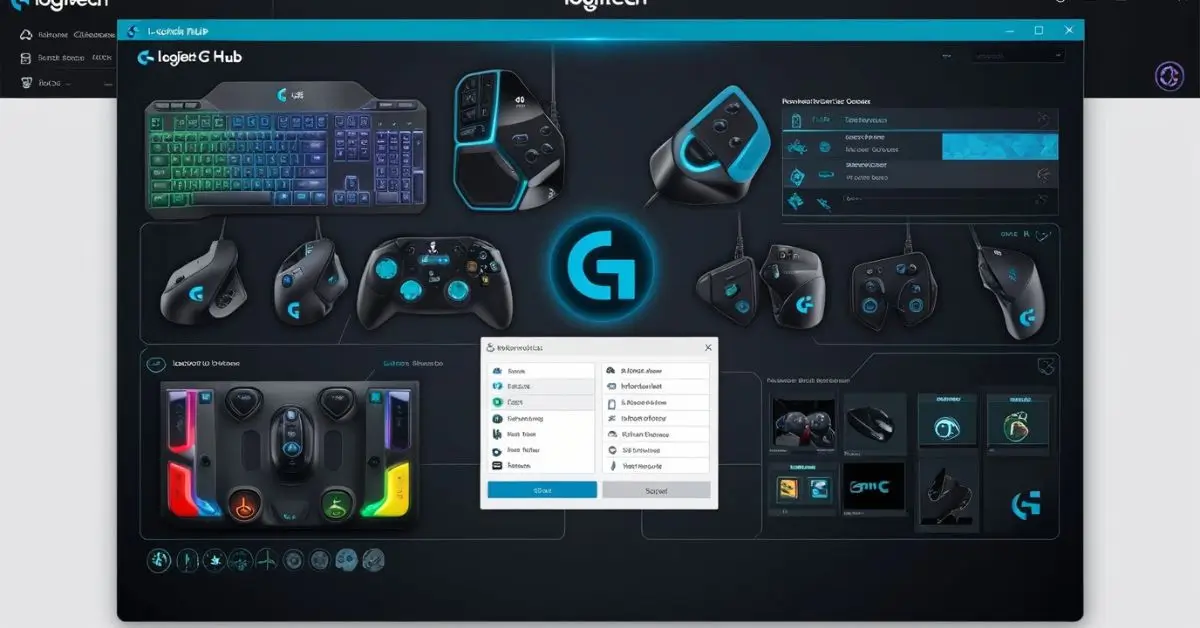In the high-stakes world of PC gaming, victory is often decided by milliseconds, pixel-perfect precision, and flawless execution. It’s a universe where hardware isn’t just a tool; it’s an extension of the player. For years, Logitech G has been at the forefront of crafting this hardware, producing some of the most iconic mice, keyboards, and headsets in esports history. But powerful hardware requires equally powerful software to unlock its full potential. Enter Logitech G Hub: the ambitious, all-in-one application designed to be the central nervous system for your entire Logitech G ecosystem.
More than just a configuration tool, G Hub represents a philosophy—a belief that personalization is the key to peak performance. This article delves deep into the world of G Hub, exploring its core features, its transformative impact on the gaming experience, and how to master its interface to build your ultimate setup.
From Legacy to Modernity: The Genesis of G Hub
To understand G Hub, it’s helpful to look at its predecessor, the Logitech Gaming Software (LGS). LGS was a workhorse, reliable and feature-rich, but it began to show its age. Its interface felt dated, and as Logitech’s product line exploded with new, technologically advanced peripherals, LGS struggled to cohesively integrate them all.
Logitech G Hub was born from the need for a modern, scalable, and user-friendly platform. It was designed from the ground up to handle the complexities of today’s gaming gear, from advanced LIGHTSYNC RGB lighting to sophisticated sensor tuning and Blue VO!CE microphone filters. It’s a software suite built not just for the games of today, but for the future of interactive entertainment.
Deconstructing the Hub: A Tour of the Core Features
Upon launching G Hub, you’re greeted with a sleek, dark-themed interface that is both minimalist and powerful. The home screen prominently displays your connected Logitech G devices, each one a gateway to a deep well of customization.
1. Profiling and Personalization: The Heart of G Hub
The most critical concept in G Hub is the Profile. A profile is a collection of settings for all your connected devices. The software’s brilliance lies in its automation.
- Game-Specific Profiles: G Hub can automatically detect when you launch a game and switch to a pre-configured profile tailored specifically for that title. This means your mouse DPI shifts to your preferred sniping sensitivity in Call of Duty, your keyboard lights up with ability keys in League of Legends, and your headset activates a surround sound profile for Cyberpunk 2077—all without you lifting a finger.
- On-Board Memory Profiles: For gamers who compete on different machines or prefer to avoid software running in the background, G Hub allows you to save profiles directly to your device’s onboard memory. Your perfect settings travel with you, anywhere you go.
2. Lighting 2.0: Beyond Simple RGB with LIGHTSYNC
Logitech’s LIGHTSYNC RGB technology is a generational leap beyond simple static lighting. Within G Hub, you can create breathtaking visual experiences:
- Preset Effects: Choose from a wide array of effects like Color Wave, Breathing, Screen Sampler, and Audio Visualizer that makes your setup pulse with your music or game audio.
- Game Integration: This is where magic happens. Supported games can directly control your RGB lighting. Imagine your keyboard flashing red and blue when you’re wanted in Grand Theft Auto V, or your mousepad glowing with the cooldown timer of your ultimate ability in Overwatch 2. This level of immersion seamlessly blends the virtual world with your physical space.
- Fine-Tuned Control: For the meticulous creator, every single LED on every supported device can be individually customized, allowing for truly unique and personal lighting setups.
3. The Blue VO!CE Revolution: Broadcasting Your Best Voice
For streamers and content creators, audio quality is paramount. Logitech’s partnership with Blue Microphones culminated in the integration of Blue VO!CE software directly into G Hub. This suite of real-time microphone filters is a game-changer.
Instead of needing complex third-party software like Voicemeeter or a physical audio mixer, G Hub provides a one-stop shop for crystal-clear communication. You can apply:
- Noise Removal: Eliminates keyboard clacks, mouse clicks, and background fan noise.
- Expander Gate: Cuts out any sound below a set threshold, ensuring silence when you’re not speaking.
- Compressor: Balances your audio levels, preventing loud shouts from peaking and quiet speech from being inaudible.
- De-Esser and De-Popper: Removes harsh “s” sounds and plosives like “p” and “b” pops.
This powerful toolset ensures your voiceovers, Discord chats, and live streams are professional and pristine.
4. Performance Tuning: Precision at Your Fingertips
At its core, G Hub is about performance. The tuning options for each device are exhaustive:
- Mice: Adjust DPI sensitivity in steps (from 100 to 25,600+ on some models), set polling rates (1000Hz for 1ms response), customize button assignments, and fine-tune surface tuning for optimal tracking.
- Keyboards: Remap any key, create complex macros with easy-to-use recording tools, and set up per-key lighting for maximum efficiency and flair.
- Headsets: Configure surround sound settings, adjust equalizer presets for music, FPS, or MOBA games, and balance your audio mix between game and chat audio.
Navigating the Learning Curve: Tips for Mastery
While powerful, G Hub’s depth can be initially daunting. Here’s how to get the most out of it:
- Start with Automatic Game Detection: Don’t try to manually configure everything at once. Let G Hub do the work. Play your games and let it create the initial profiles. You can then fine-tune these profiles later.
- Master the Macro Recorder: Macros can automate complex sequences of actions. Instead of just recording keystrokes, use the built-in editing tools to add delays and commands, transforming a cumbersome combo into a single button press.
- Experiment with Layers: For mice with multiple buttons (like the G502 or G600), use G Hub’s “G-Shift” function. This acts as a modifier key, effectively doubling the number of commands you can assign by creating a second “layer” of functions.
- Sync Your Ecosystem: If you have multiple LIGHTSYNC devices, use the “Integrations” tab to create a unified lighting theme that flows across your entire desk setup, creating a cohesive and immersive ambient experience.
Acknowledging the Journey: The Road Ahead for G Hub
It would be remiss not to acknowledge that G Hub’s launch and early years were not without turbulence. Many longtime users migrating from LGS reported bugs, high CPU usage, and occasional instability. Logitech has been on a continuous journey of refinement, issuing numerous updates that have dramatically improved the software’s reliability and performance.
While the experience is now smooth for the vast majority of users, this history is a testament to the immense challenge of developing a unified software platform that must control a diverse and ever-growing range of complex hardware. The lesson for users is simple: keep your G Hub updated. The latest version is almost always the most stable and feature-complete.
Conclusion: More Than Software, It’s Your Strategic Advantage
Logitech G Hub has evolved from a ambitious project into an indispensable platform for any serious gamer invested in the Logitech G ecosystem. It transcends its role as mere configuration software to become a central command hub that unlocks the true DNA of your gear.
It understands that no two gamers are alike. The professional esports athlete needs raw, unfiltered performance. The immersive single-player enthusiast craves atmospheric lighting and rich audio. The content creator demands studio-quality voice modulation. G Hub caters to them all, offering a staggering depth of customization wrapped in a modern, increasingly intuitive interface.
By mastering Logitech G Hub, you are not just changing settings; you are engineering your advantage. You are tailoring your tools to fit your hand, your playstyle, and your moment-to-moment needs in the digital arena. It is the final, crucial piece of the puzzle that transforms a collection of high-end peripherals into a unified, responsive, and truly personal instrument of victory.

